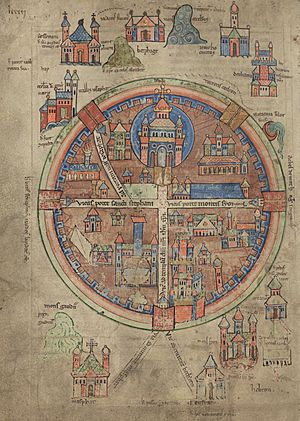Sæwulf facts for kids

Sæwulf was an English traveler who went on a long journey to Jerusalem around the year 1102. He was probably the first person from England to visit Jerusalem after it was captured by the First Crusade. Sæwulf wrote down his experiences in a book written in Latin. His story shows how difficult and dangerous travel was back then. It also gives us a quick look at sea travel across the Mediterranean Sea and what the new Kingdom of Jerusalem was like after the Crusade.
Contents
Sæwulf's Journey to Jerusalem
Jerusalem was captured by soldiers of the First Crusade in 1099. Sæwulf began his trip, called a pilgrimage, to the Holy Land on July 13, 1102. He started by getting on a ship in Monopoli, a town in Apulia.
He sailed to many different ports before landing at Jaffa. From there, he began exploring Palestine. His journey included visits to places like Jericho and Hebron.
Dangers on the Road to Jerusalem
Sæwulf wrote about how unsafe the roads were in the Judean hills at that time. He said the road between Jaffa and Jerusalem was "very dangerous." This was because groups called Saracens were "continually plotting an ambush." They were always looking for someone to attack, day and night.
In Jerusalem, Sæwulf wrote down details about important places for visitors. He described famous sites like the Church of the Holy Sepulchre. It was almost like a travel guide for other pilgrims.
The Return Voyage
For his trip home, Sæwulf left Jaffa in May 1103. He traveled on a type of ship called a dromund. Near Acre, Saracen ships attacked his boat. But the soldiers on board fought back and protected the ship, allowing it to escape.
Later, on his journey from Cyprus to Constantinople, pirates attacked them again. Sæwulf's story suddenly stops after he describes passing through the Dardanelles.
Sæwulf's Story and Later Life
In 1839, Sæwulf's travel report was edited into French by Armand d'Avezac. Then, in 1848, Thomas Wright translated it into English. He included it in his book "Early Travels in Palestine" as a section called "The Travels of Sæwulf."
We don't know much about Sæwulf's life after his pilgrimage. However, many people believe he is the same Sæwulf mentioned by a famous English historian named William of Malmesbury. This historian wrote that Sæwulf (also called Seuulfus) was a merchant from Worcester. He later became a monk at Malmesbury Abbey in Wiltshire, England, when he was older.
See also
- Sea in culture
- Daniel the Traveller
Work

